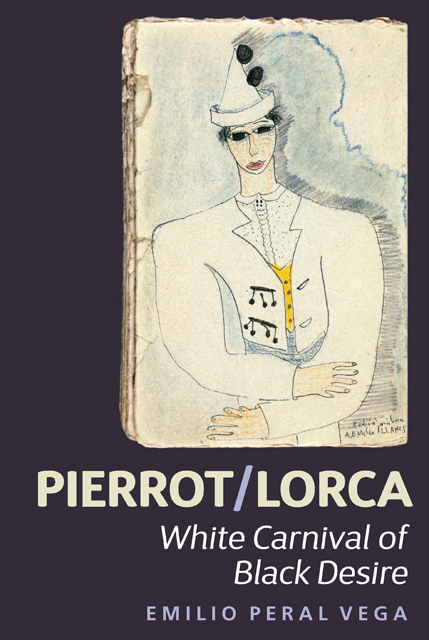Book contents
- Frontmatter
- Dedication
- Contents
- List of Illustrations
- Acknowledgements
- Prologue
- 1 A Modern Mask: From Deburau to The Tramp
- 2 First Examples of an Effeminate Pierrot: From Verlaine to Lorca
- 3 Pierrot/Lorca: Alter Ego for a Young Poet
- 4 Lorca/Pierrot: Between Painting and Theatre
- 5 Love Game and Masquerade: Dalí/Lorca
- 6 Perlimplín/Lorca/Pierrot: Frustrated Desire
- 7 A White Clown for a Black Desire: El público and Así que pasen cinco años
- Epilogue
- Bibliography
- Index
- Frontmatter
- Dedication
- Contents
- List of Illustrations
- Acknowledgements
- Prologue
- 1 A Modern Mask: From Deburau to The Tramp
- 2 First Examples of an Effeminate Pierrot: From Verlaine to Lorca
- 3 Pierrot/Lorca: Alter Ego for a Young Poet
- 4 Lorca/Pierrot: Between Painting and Theatre
- 5 Love Game and Masquerade: Dalí/Lorca
- 6 Perlimplín/Lorca/Pierrot: Frustrated Desire
- 7 A White Clown for a Black Desire: El público and Así que pasen cinco años
- Epilogue
- Bibliography
- Index
Summary
Pierrot/Lorca: White Carnival of Black Desire is an essay which I have long considered, born of my fascination with one of the icons of modernity at the end of the nineteenth century and beginning of the twentieth: Pierrot. This is an ancient mask that derives from the Italian Petrolino of the commedia dell’arte and that has been resignified, as we will see, starting with Jean-Gaspard Deburau, until it has become a literary stereotype of European modernism and, more specifically, Spanish modernism. I dedicated a chapter to this enigmatic, sad simpleton, who is also an idealist and poet, in Formas del teatro breve español en el siglo XX (1892–1939) (2001), and again in an anthology of French, Latin American and Spanish texts gathered under the title La vuelta de Pierrot. Poética moderna para una máscara antigua (2007), as well as the monograph De un teatro en silencio. La pantomima en España de 1890 a 1939 (2008).
A detailed reflection on this loser and buffoon has revealed to me, with the passage of the years, the central position he occupies in Lorca’s imagery. In spite of the huge number of studies on the life and works of the poet and playwright from Fuente Vaqueros, and the growing number of investigations of Lorca’s masks, the truth is that very few have focused on Pierrot and his intimate relationship with Lorca, with the exception of the pioneering efforts undertaken by my good friend David George, whose work The History of the Commedia dell’arte in Modern Hispanic Literature with Special Attention to the Work of García Lorca (1995) is in many respects still a critical touchstone. Commedia dell’arte and its influence on Spanish and Catalan theatre are both subjects to which George has dedicated a number of crucial contributions. I want to bring a new perspective to the poetic, prose, theatrical and even pictorial works of Federico García Lorca, focusing on Pierrot as a mechanism for representing intimacy, developed by the poet around 1918 and maintained as a constant throughout his career as a means to know himself, hide himself and reveal himself.
- Type
- Chapter
- Information
- Pierrot/LorcaWhite Carnival of Black Desire, pp. 1 - 10Publisher: Boydell & BrewerPrint publication year: 2015

